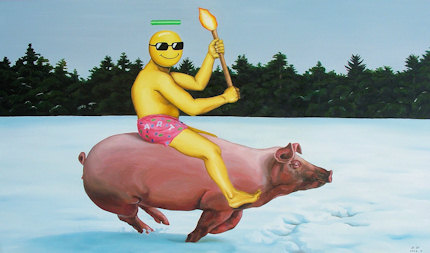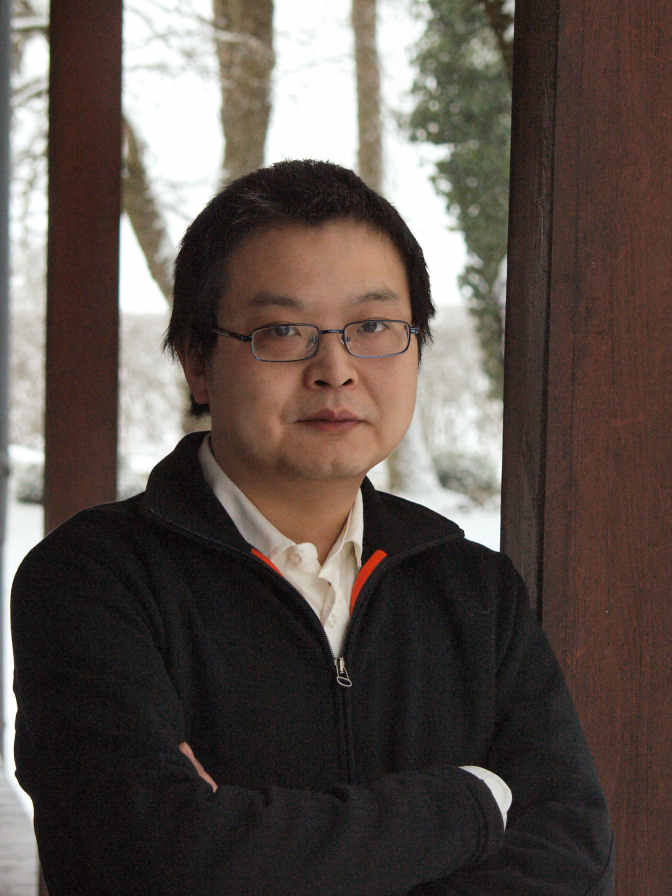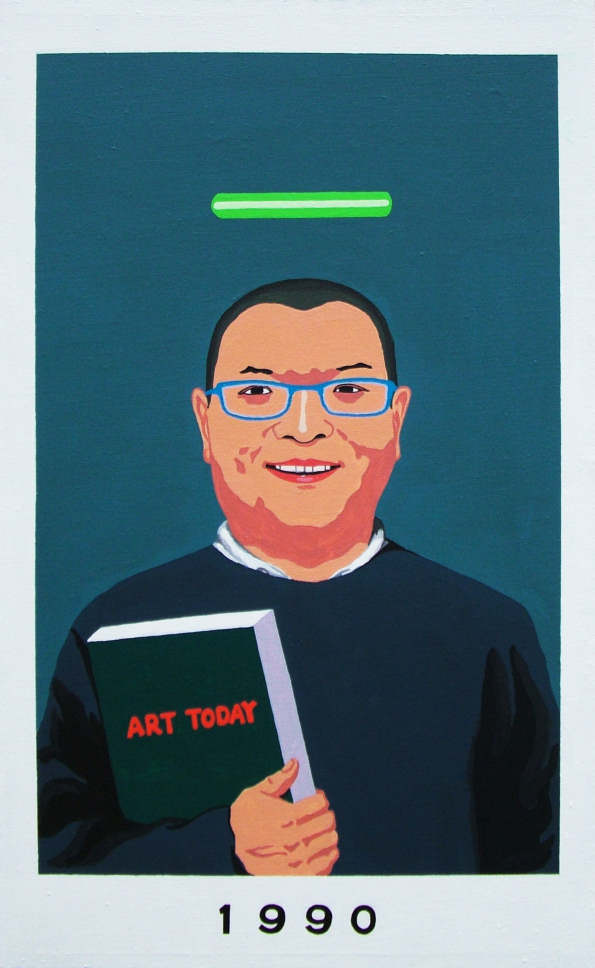Express yourself - smileyworld ltd. (Zhao Bin)
Zu der "Smiley" Serie von Zhao Bin freuen wir uns, einen interessanten Essay von Horst Baur präsentieren zu dürfen:
"Sag es" smileyworld ltd.
einige Anmerkungen zu den neuen Bildern von Zhao Bin
I.
Der Ausgangspunkt der neuen Serie von Zhao Bins Arbeiten ist die europäische Kunstgeschichte. Seine eigene Zeitreise. Europäische Malerei dient dabei oft als eine ideale Kinoleinwand, auf die alle Arten von Fantasien projeziert werden können - z. B. ein Historienbild. In all diesen Fällen erzählen uns die Ergebnisse weniger über den Charakter des (Zeit-)Reisenden, viel aber über die Antriebe, Interessen und Ideale derer, die an diesen Projektionen beteiligt sind.
Im Fall von Zhao Bins Zeitreise in der Kunstgeschichte befasst sich Zhao Bin vorwiegend mit seiner ureigenen Art der Umsetzung und deren Wirkung auf den Betrachter.
Das ist seine Stellungsnahme zu seinem Verständnis europäischer Kunst. Nicht umsonst. Die Arbeiten, die ihm zum Vorwurf dienen, sind in China bekannt. Nicht nur in chinesischen Kunstakademien, wo diese Arbeiten als Beispiele perfekter Maltechnik dienen. Aber in Zhao Bin's Arbeiten ist die Technik mutig und verblüffend, wie wir es aus der Pop Art kennen.
II.
Ein Smiley (auch Smilie oder Grinser) ist die grafische Darstellung eines lächelnden Gesichtes. Das Wort „Smiley“ wird gelegentlich für jede Art von Emotikon verwendet. Es wird üblicherweise in Form eines gelben Kreises dargestellt, mit zwei Punkten als Augen und einem Halbkreis, der den Mund darstellt. (Wikipedia)
Aber - wenn das Smiley nun zur malerischen Inkarnation, d.h. Fleischwerdung des Künstlers Zhao Bin dient? Ist der "gelbe Mann" eine Bestätigung des westlichen Vorurteils über den ewig lächelnden Chinesen? Oder ein Selbstporträt, Spiegelbild einer internationalen Ikone (Marke?) ? "Ihnen einen schönen Tag" nur eine Floskel, vereitelt durch das Leben? Und wie ist es mit dem Schwein? Ist das nur ein Kamerad oder ist es Zhao Bins "alter ego"? Beides. Aber nicht in der Chinesischen Art. Es gibt keinen Bezug zu dem chinesischen Tierkreis-Zeichen. Es ist westlich. Dekandent.
Es wird aber mehr und mehr zu Zhao Bins zweitem Ich, wenn er sich in der europäischen Kunstgeschichte bewegt, in seinen "Körperstudien". Das Schwein wird eine Metapher für einen Dummkopf und einen "lüsternen alten Mann", eine Missgestalt, kaputt, aber obszön, und verloren im Exil. Er bringt sich selbst in den Bildern ein - den historischen und kulturellen Hintergrund der Malereien lässt er dabei unbeachtet: aber mit Humor. Als ein Kommentar zur chinesischen Kenntnis der europäischen Kunst. Obwohl anscheinend jeder weiss, wie zugehörig und abhängig die Kunst von geschichtlichen Umständen ist - Zhao Bin findet den Weg, uns das noch mehr bewusst zu machen. Alle Figuren in den (Bild-)Geschichten sind real, aber die Beziehungen zwischen ihnen sind rein erfunden.
....

Zhao Bin: Fackellauf, 2008
IV.
Zhao Bin reitet wieder. Auf seinem Kameraden, dem Schwein. Zu neuen Ufern - oder sollte ich sagen: zu den alten Grenzpfählen?
Horst Baur, Changsha 2008. Mit freundlicher Genehmigung des Autors, Übersetzung: Dr. Erdel Verlag
Text in Englisch:“express yourself” smileyworld ltd.
some notes to zhao bin’s new paintings
I.
the departure point of zhao bin’s new works series is the European art history. his own travel in time.
european paintings often serve as the ideal blank screen upon which all sorts of fantasies may be projected – e.g. profiling in history. in all of these instances, the end results tell us little about the character of their travellers, and much about the needs, concerns and ideals of those engaged in these projections.
in the case of zhao bin’s time travel in art history, the attention is directed toward his own very practice of projection and its workings to the viewers.
it is a comment on his own knowledge of European art. not for nothing. the works zhao bin reflects are popular in China. not only in chinese art academies where these works serve as examples for perfect technics in painting. but in zhao bin’s works the technics are bold, striking as it is common in pop art.
II.
The smiley, smiley face, or happy face, is a stylized representation of a smiling human face, commonly represented as a yellow circle with two dots representing eyes and a half circle representing the mouth. (Wikipedia)
but- when the smiley is used as an incarnation of the chinese artist zhao bin?
is it the “yellow man” , an affirmation of the western prejudice of the ever smiling chinese man? or a self-portrait, reflecting an international icon?
“have a happy day”, only a phrase, thwarted by real life?
and what about the pig? is it only a companion or is it the artist’s alter ego?
both. not in the chinese way. no reference to the chinese zodiac sign.
it’s western. decadent.
it becomes more and more zhao bin’s alter ego when he travels in Europe’s art history, in its “studies of bodies”: the pig becomes a metaphor for an idiot and a “dirty old man”- a cretin, broken, but obscene. and lost in exile.
he enrolls himself in the paintings- ignoring the historical and cultural background of the paintings:
but in a humorous way. As a comment on the chinese knowledge of the European art.
although everybody seems to know how relative and dependent on historic circumstances is – zhao bin finds ways to get more aware about it. all the characters in the stories are real, but the connections between them are fictional.
III.
Anonymous Artist
Gabrielle d’Estrees and One of her Sisters (ca. 1594)
her sister is pinching her nipple indicating she is pregnant with the king's child.
EduardManet
Olympia (1863)
it humanizes prostitution which was not, in a time where no one wanted to be reminded of the shadier side of life, a very popular thing to do.
Lucian Freud
Hotel bedroom (1954)
paintings such as this were, at the time, regarded by many as shocking, violent and cruel.
IV.
zhao bin rides again. on his companion, the pig. to new frontiers. or should I say: to old frontiers?
horst baur, Changsha, 2008-9-1 (courtesy Horst Baur)


